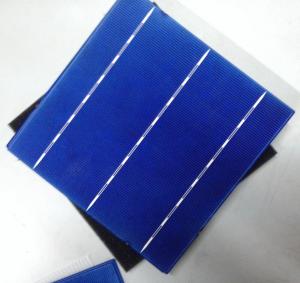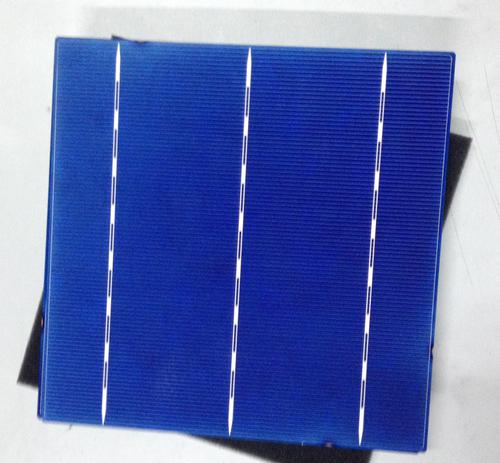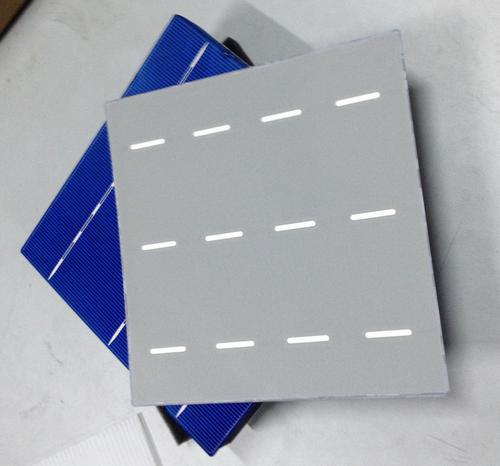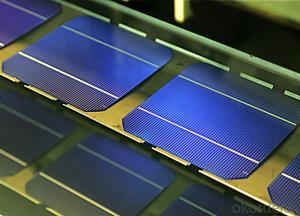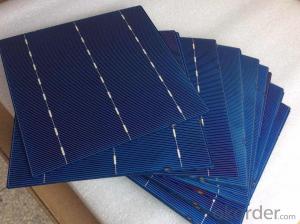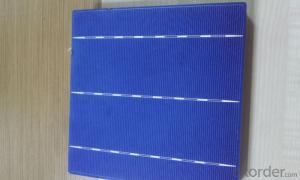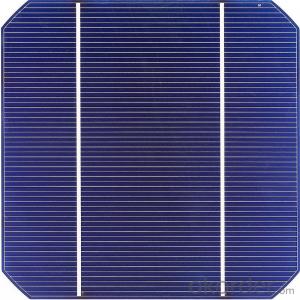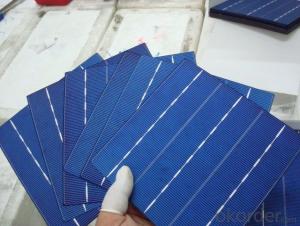Carbon Based Polycrystalline Solar Cells - Tire 1 Manufacturer
- Loading Port:
- Shanghai
- Payment Terms:
- TT OR LC
- Min Order Qty:
- 10000 pc
- Supply Capability:
- 50000000 pc/month
OKorder Service Pledge
OKorder Financial Service
You Might Also Like
Specifications of Poly Solar Cells
Format 156 mm × 156 mm ± 0.5 mm
Thickness- 210μm ± 40 μm
Front (-) 1.5mm bus bars (silver),blue anti-reflection coating (silicon nitride)
Back (+) 2.5mm wide soldering pads (silver) back surface field (aluminium)
Temperature Coefficient of Poly Cells
Voc.Temp .coef.%/K -0.351%/K
Isc.Temp .coef.%/K +0.035%/K
Pm.Temp. coef.%/K -0.47%/K
Electrical Characteristic of Poly Cells
| Efficiency | Efficiency | Pmax(W) | Average | Impp(A) | Vmpp(V) | Isc(A) | Voc(V) |
| 1720 | 17.20~17.40 | > 4.186 | > 4.186 | 7.94 | 0.528 | 8.515 | 0.626 |
| 1700 | 17.00~17.20 | 4.137~4.186 | 4.161 | 7.905 | 0.525 | 8.482 | 0.624 |
| 1680 | 16.80~17.00 | 4.088~4.137 | 4.113 | 7.863 | 0.521 | 8.402 | 0.623 |
| 1660 | 16.60~16.80 | 4.040~4.088 | 4.064 | 7.825 | 0.519 | 8.358 | 0.622 |
| 1640 | 16.40~16.60 | 3.991~4.040 | 4.015 | 7.769 | 0.517 | 8.304 | 0.621 |
| 1620 | 16.20~16.40 | 3.942~3.991 | 3.967 | 7.713 | 0.514 | 8.248 | 0.619 |
| 1600 | 16.00~16.20 | 3.894~3.942 | 3.918 | 7.67 | 0.511 | 8.204 | 0.616 |
Advantages of Poly Solar Cells
1. High efficiency and High power.
2. Long-term electrical stability.
3. Lowest price and Fastest delivery.
4. Good quality and good service.
5. Bulk supply
6. Good Warranty
7. Big Sale
8. More than 25 years on the lifetime.
Usage and Applications of Poly Cells
Solar cells are often electrically connected and encapsulated as a module. Photovoltaic modules often have a sheet of glass on the front (sun up) side, allowing light to pass while protecting the semiconductor wafers from abrasion and impact due to wind-driven debris, rain, hail, etc. Solar cells are also usually connected in series in modules, creating an additive voltage. Connecting cells in parallel will yield a higher current;our solar cells have passed IEC Certification. With high quality and stable quality. Our Cells can greatly improve the performance of Solar Modules.
Packaging & Delivery of Poly Cells
Carton Box Package and Deliver by air. It should be noticed that it should be avoid water, sunshine and moist.
FAQ
We have organized several common questions for our clients,may help you sincerely:
1. What’s price per watt?
A: It’s depends on the quantity, delivery date and payment terms of the order. We can talk further about the detail price issue. Our products is high quality with lower price level.
2. Can you tell me the parameter of your solar cells?
We have different series of cells with different power output, both from c-si to a-si. Please take our specification sheet for your reference.
3. How do you pack your products?
We have rich experience on how to pack the panels to make sure the safety on shipment when it arrives at the destination.
4. Can you do OEM for us?
Yes, we can.
5. How long can we receive the product after purchase?
In the purchase of product within three working days, We will arrange the factory delivery as soon as possible. The perfect time of receiving is related to the state and position of customers. Commonly 7 to 10 working days can be served.
Factory Picture
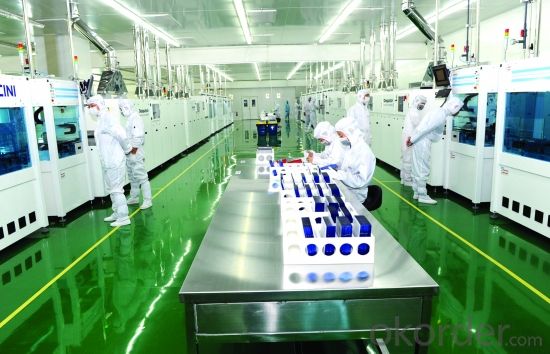

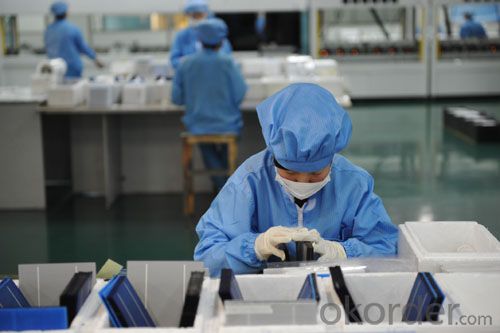
- Q: Can solar cells be used to power wireless communication networks?
- Yes, solar cells can be used to power wireless communication networks. Solar cells are capable of converting sunlight into electricity, which can be stored in batteries or directly used to power various devices, including wireless communication equipment. This renewable energy source offers a sustainable and environmentally friendly solution for powering wireless networks in remote or off-grid locations. Additionally, advancements in solar cell technology have made them more efficient and cost-effective, making them a viable option for powering these networks.
- Q: What is the role of junction boxes in solar cell systems?
- Junction boxes in solar cell systems serve as a crucial component for electrical connections and system protection. They are responsible for housing and safeguarding the electrical connections between solar panels, allowing the flow of electricity to and from the panels. Additionally, junction boxes play a vital role in preventing damage from environmental factors such as moisture, dust, and excessive heat.
- Q: Are solar cells affected by temperature?
- Yes, solar cells are affected by temperature. High temperatures can cause a decrease in the efficiency of solar cells, resulting in a reduction in their power output. However, modern solar cell technologies have been developed to minimize the impact of temperature on their performance.
- Q: How do solar cells perform in areas with frequent thunderstorms?
- Solar cells can still perform efficiently in areas with frequent thunderstorms, although their performance may be affected during periods of heavy cloud cover or rainfall. Thunderstorms can temporarily reduce sunlight exposure, leading to a decrease in solar cell output. However, solar cells are designed to withstand various weather conditions, and their performance can quickly recover once the storms pass. Additionally, advancements in solar technology, such as the use of anti-reflective coatings and improved cell designs, help to enhance performance even in less ideal weather conditions.
- Q: How can the huge solar cells be applied into the market?
- If you are just using power supply for daily usage, such as a family of 6, you don’t need the huge solar cells.
- Q: Can solar cells be used in off-grid systems?
- Yes, solar cells can be used in off-grid systems. Off-grid systems, also known as standalone systems, are independent of the traditional electrical grid, and solar cells are a reliable and cost-effective way to generate electricity in such systems. By harnessing sunlight and converting it into electricity, solar cells can provide a sustainable and renewable energy source for off-grid applications such as remote cabins, boats, or even emergency backup power systems.
- Q: Can solar cells be installed on any type of roof?
- Solar cells can be installed on most types of roofs, including flat, sloped, and even curved roofs. However, the feasibility and efficiency of installation may vary depending on factors such as roof orientation, shading, structural integrity, and local regulations. It is advisable to consult with a professional solar installer to determine the suitability of your specific roof for solar panel installation.
- Q: Can solar cells be used in residential applications?
- Yes, solar cells can be used in residential applications. They are commonly used to generate electricity for homes by converting sunlight into electrical energy. This renewable energy source can help reduce reliance on traditional electricity grids, lower electricity bills, and contribute to a more sustainable and environmentally friendly lifestyle.
- Q: How do solar cells affect the value of a property?
- Solar cells can positively affect the value of a property by reducing energy costs, generating income through net metering or feed-in tariffs, and increasing its overall sustainability and appeal to potential buyers.
- Q: Are solar cells affected by temperature changes?
- Yes, solar cells are affected by temperature changes. Higher temperatures can cause a decrease in the efficiency of solar cells, as the increase in temperature can lead to an increase in resistance within the cells, resulting in reduced power output. Conversely, lower temperatures can improve the performance of solar cells, increasing their efficiency.
Send your message to us
Carbon Based Polycrystalline Solar Cells - Tire 1 Manufacturer
- Loading Port:
- Shanghai
- Payment Terms:
- TT OR LC
- Min Order Qty:
- 10000 pc
- Supply Capability:
- 50000000 pc/month
OKorder Service Pledge
OKorder Financial Service
Similar products
Hot products
Hot Searches
Related keywords


